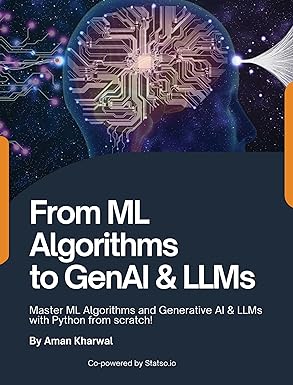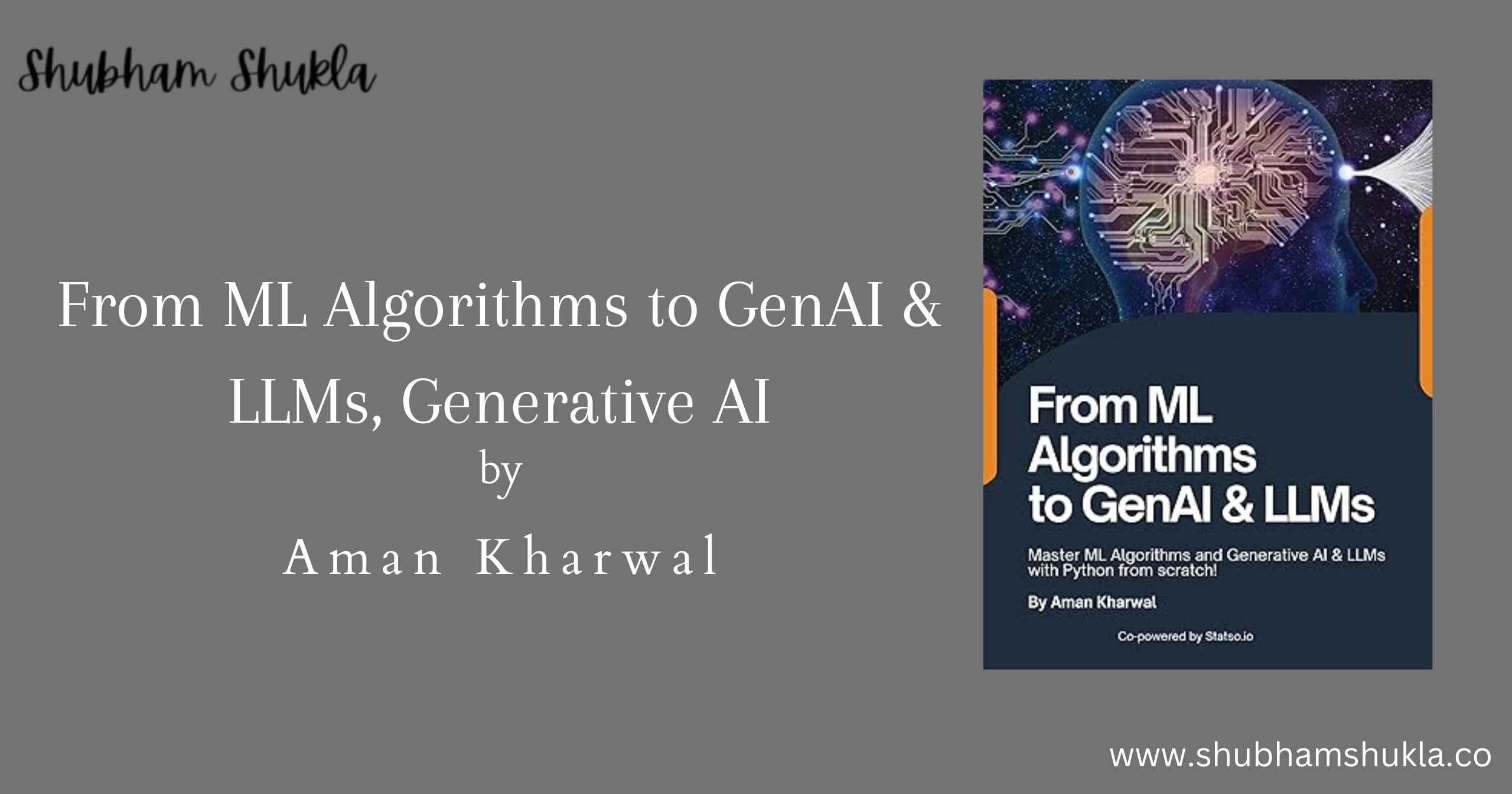Introduction to ML Algorithms and Generative AI
Machine Learning (ML) has transformed the way we interact with technology, and Aman Kharwal’s book, “From ML Algorithms to GenAI & LLMs: Master ML Algorithms and Generative AI & LLMs with Python from scratch!” is a fantastic resource for both beginners and intermediate learners. This book bridges the gap between classic machine learning algorithms and cutting-edge technologies such as Generative AI (GenAI) and Large Language Models (LLM).
In this in-depth review, we’ll look at the book’s structure, important takeaways, and why it’s a must-read for anyone who wants to learn ML Algorithms, GenAI, and LLMs from scratch with Python.
Why This Book Stands Out in the World of ML Algorithms and GenAI
The field of ML Algorithms is vast, and integrating Generative AI and LLMs into the mix makes it even more complex. Aman Kharwal simplifies these concepts with hands-on Python examples, ensuring readers gain practical knowledge.
Key Features of the Book:
- Step-by-step Python implementations of ML Algorithms
- In-depth coverage of GenAI and LLMs
- Real-world applications of machine learning and generative models
- Beginner-friendly explanations with advanced insights
From ML Algorithms to GenAI & LLMs, Generative AI
From machine learning algorithms to GenAI and LLMs, The second edition of Machine Learning Algorithms: Handbook was written by Aman Kharwal, the creator of Statso.io.
Buy Now

Understanding ML Algorithms: The Foundation
What Are ML Algorithms?
ML Algorithms form the backbone of artificial intelligence. They enable systems to learn from data, identify patterns, and make decisions with minimal human intervention. Kharwal’s book starts with fundamental ML Algorithms, including:
Supervised Learning
Supervised learning is a fundamental machine learning approach in which models are trained on labeled datasets, implying that each input is associated with a corresponding output.
Linear regression, decision trees, and neural networks are examples of algorithms that learn patterns from data and use them to predict or classify it.
This approach is commonly used in applications including spam detection, medical diagnostics, and speech recognition.
Supervised learning allows AI-driven systems to make correct and efficient decisions by continuously refining predictions using labeled examples.
Unsupervised Learning
Unsupervised learning is a machine learning (ML) approach that detects patterns and structures in data without labeled outputs. Unlike supervised learning, it investigates datasets to uncover latent associations, making it perfect for clustering, anomaly detection, and dimensionality reduction. Common clustering algorithms include k-means, hierarchical clustering, and principal component analysis (PCA).
Unsupervised learning is frequently utilized in applications such as consumer segmentation, recommendation systems, and fraud detection, and it plays an important part in AI-powered decision-making.
You may also like: Powerful Adjectives to Describe a Person (With Examples & Tips)
Reinforcement Learning Basics
Reinforcement learning (RL) is a basic machine learning (ML) paradigm in which an agent learns by interacting with its environment in order to maximize cumulative rewards. Unlike supervised learning, RL does not use labeled data and instead employs trial-and-error exploration driven by incentive signals.
Key concepts include states, actions, rewards, and policies. RL drives applications such as game AI, robotics, and autonomous systems, making it critical for future developments in artificial intelligence, such as generative AI and massive language models.
You may also read: In the Silence You Left Behind a Book by Sumitra Manda
Why Mastering ML Algorithms is Crucial for GenAI & LLMs
Mastering machine learning (ML) methods is critical for developing Generative AI (GenAI) and large language models (LLMs), which rely on advanced algorithms to process big datasets, generate human-like prose, and improve over time.
Modern LLMs are based on key machine learning techniques such as neural networks, reinforcement learning, and transformer topologies, which allow them to grasp context, predict responses, and adjust dynamically. Efficient algorithm optimization improves model accuracy, lowers biases, and increases scalability.
As GenAI advances, competence in machine learning algorithms enables better innovation, responsible AI development, and improved performance in applications like chatbots, content generation, and automated decision-making systems.
Transitioning from ML Algorithms to Generative AI (GenAI)
What is Generative AI (GenAI)?
GenAI refers to AI models that generate new content—text, images, music, and more—based on learned patterns. Kharwal’s book introduces:
Generative Adversarial Networks (GANs)
Generative Adversarial Networks (GANs) are a significant step toward the move from classical machine learning (ML) methods to generative AI (GenAI). GANs, first introduced by Ian Goodfellow in 2014, are made up of two neural networks—the generator and the discriminator—that compete in a zero-sum game to produce highly realistic data.
This architecture has transformed fields including image synthesis, deep fakes, and data augmentation. Unlike traditional machine learning models, which rely on labeled data, GANs learn to generate new, high-quality content on their own.
Their ability to generate realistic results has paved the path for modern GenAI applications like creative design and synthetic media generation.
Variational Autoencoders (VAEs)
Variational Autoencoders (VAEs) are a type of generative model that combines traditional machine learning (ML) algorithms with contemporary Generative AI. VAEs, which were introduced as a probabilistic approach to autoencoders, train efficient latent data representations while allowing for the controlled creation of fresh samples.
They use encoder-decoder architectures with latent space regularization and variational inference. VAEs are widely employed in image synthesis, anomaly detection, and data augmentation, therefore they are an essential step in the shift from ML-based feature learning to advanced GenAI models.
Diffusion Models
Diffusion models are a key improvement in generative AI, providing a powerful framework for producing high-quality images, sounds, and text.
These models work by gradually converting random noise into structured data using a series of repeated denoising procedures. Unlike typical machine learning algorithms, diffusion models use probabilistic strategies to produce greater realism and diversity.
They have been widely used in AI research, enabling developments like OpenAI’s DALL·E and Google’s Imagen, indicating a shift towards more creative and expressive AI applications.
How ML Algorithms Pave the Way for GenAI
Machine learning (ML) algorithms are the foundation of generative AI (GenAI), allowing systems to learn patterns, create new content, and improve over time. Deep learning, reinforcement learning, and transformers are driving breakthroughs in GenAI models, enabling them to generate human-like text, graphics, and code.
ML algorithms help to refine large language models (LLMs) by training them on big datasets, optimizing answers, and improving contextual comprehension. This progress closes the gap between classical AI and more autonomous, creative AI systems.
You may also like: Think and Grow Rich Summary: Key Lessons and Takeaways
Hands-On Python Implementation: From ML Algorithms to LLMs
Why Python for ML Algorithms and GenAI?
Python is the ideal language for machine learning (ML) algorithms and Generative AI (GenAI) due to its ease of use, rich libraries, and active community. TensorFlow, PyTorch, and Scikit-learn allow for rapid model creation, while Pandas and NumPy make data handling easier.
Python’s adaptability enables seamless integration with deep learning frameworks, making it excellent for large-scale AI applications, such as large language models (LLMs). Its clarity and thorough documentation help academics and developers create cutting-edge AI systems.
Key Python Exercises in the Book
- Building a Linear Regression Model from Scratch
- Training a GAN for Image Generation
- Fine-tuning an LLM for Text Completion
Real-World Applications of ML Algorithms, GenAI, and LLMs
Industry Use Cases
- Healthcare: Predictive diagnostics using ML Algorithms
- Entertainment: AI-generated content via GenAI
- Customer Support: Chatbots powered by LLMs
Future Trends in ML and Generative AI
Aman Kharwal discusses emerging trends, including:
- Multimodal AI (Combining Text, Image, and Audio Models)
- Self-Supervised Learning for LLMs
Pros and Cons of the Book
Pros
- Clear explanations of complex topics
- Practical Python coding exercises
- Covers both foundational and advanced AI concepts
Cons
- Assumes basic Python knowledge (not for absolute beginners)
- Limited coverage of cloud-based AI deployment
Who Should Read This Book?
“From ML Algorithms to GenAI & LLMs” is perfect for:
- Aspiring Data Scientists & ML Engineers
- Python Developers exploring AI
- Tech Enthusiasts curious about GenAI & LLMs
Conclusion: Mastering ML Algorithms, GenAI, and LLMs Made Easy
Aman Kharwal’s book is a well-structured guide that takes readers from ML Algorithms to advanced Generative AI and LLMs. With practical Python examples and clear explanations, it’s a valuable resource for anyone looking to excel in AI.
Whether you’re a beginner or an intermediate learner, this book will help you master ML Algorithms, GenAI, and LLMs effectively.



